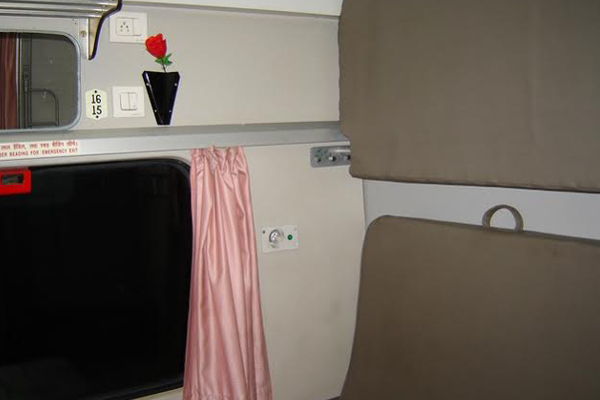
What is AC First on Indian Railways about?
For the uninitiated, AC stands for air-conditioned. 2AC is the second-most luxurious options on long-distance Indian trains each cubicle has 2+2 berth configuration; apart from two more berths on the other side of the passage. (In 3AC and Second Class, the configuration is 3+3, plus two berths on the other side of the passage).
.jpg) As the trip approached, I was as excited about my first AC First experience as the trip itself. On D-Day, I reached the train station well in time. Confirmed AC First tickets do not have seat numbers when you book them. The thing is, a regular train usually has ten or less bunks in this category (because they are overpriced and only few people want them) and the seats are allotted accordingly in the final list of passengers that is made a couple of hours before the train in scheduled to leave.
As the trip approached, I was as excited about my first AC First experience as the trip itself. On D-Day, I reached the train station well in time. Confirmed AC First tickets do not have seat numbers when you book them. The thing is, a regular train usually has ten or less bunks in this category (because they are overpriced and only few people want them) and the seats are allotted accordingly in the final list of passengers that is made a couple of hours before the train in scheduled to leave.
My train was Falaknuma Express and this train had ten seats. Two four-bunk coupes and a two-bunk one. Couples and those booking together are usually given the two-bed bunk. I found my name in Cabin B (of four bunks) with an elderly couple. One bunk was empty.
So how different is this experience? The AC First is part of a 2AC compartment. You get in and there’s a narrow door that leads to a passage with the cabins on one side. All the doors and windows have curtains on them and unlike 2AC and other categories, there are no bunks on the other side of the passage. These cabins, unlike anywhere else on the train, have doors. Slide the doors open and enter, and you find a little room with two comfortable sofas facing each other with plenty of leg space. (This immediately reminded me of the cramped airplane seats). The upper berths are in place and you can redirect the air-conditioner air vent if you’re too cold and the air is flowing directly at you. The sofas can be converted to comfortable beds at night by pulling down the backrest. You also have reading lights for each bed.
What basically sets the experience apart is the amount of personal space you get.Of course it’s the best if you are two people and get a two-bunk cabin. But even in the four-bunk version, you have cabinets to hang your clothes, trash bins that are cleared frequently, a number of plug points to charge your phones and gadgets and a bell, by which you can call attendants to your cabin.
Unfortunately, the one thing I found irritating was the fact that food is not included in your AC First ticket unless it is a Rajdhani or Satabdi category train. But you, of course, can buy food that is readily available.
My train was 3.5 hours late. Did I mind? Not one bit ;)
Support Our Journalism
We cannot do without you.. your contribution supports unbiased journalism
IBNS is not driven by any ism- not wokeism, not racism, not skewed secularism, not hyper right-wing or left liberal ideals, nor by any hardline religious beliefs or hyper nationalism. We want to serve you good old objective news, as they are. We do not judge or preach. We let people decide for themselves. We only try to present factual and well-sourced news.






